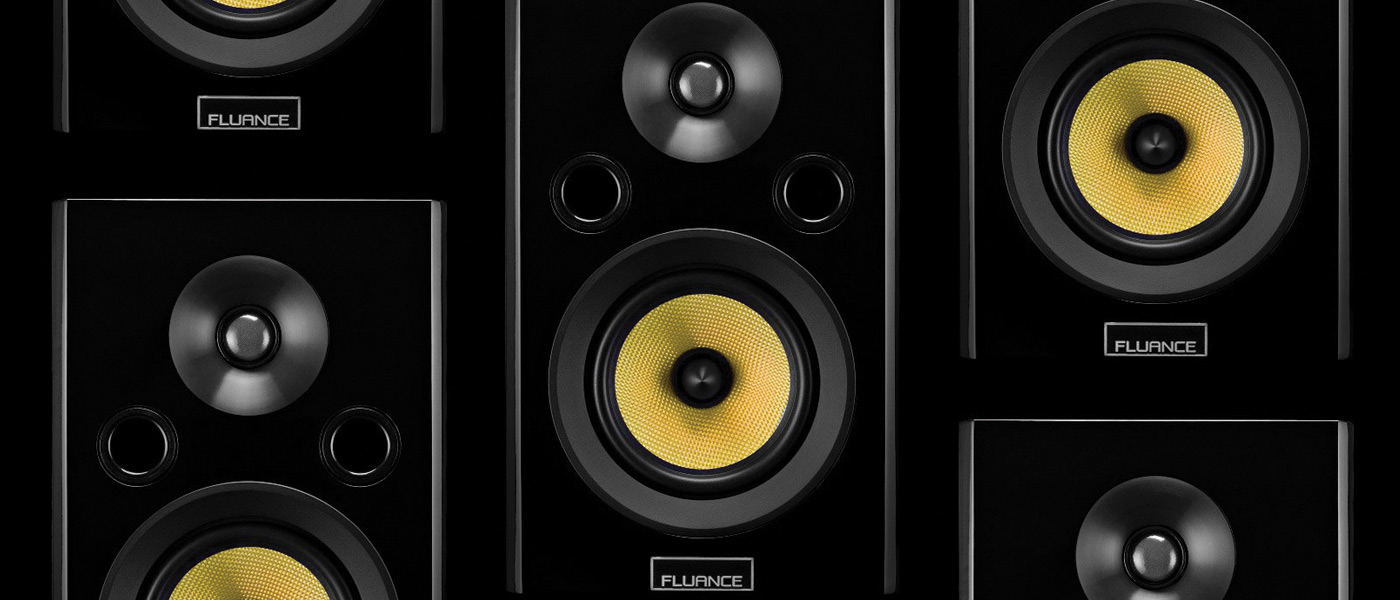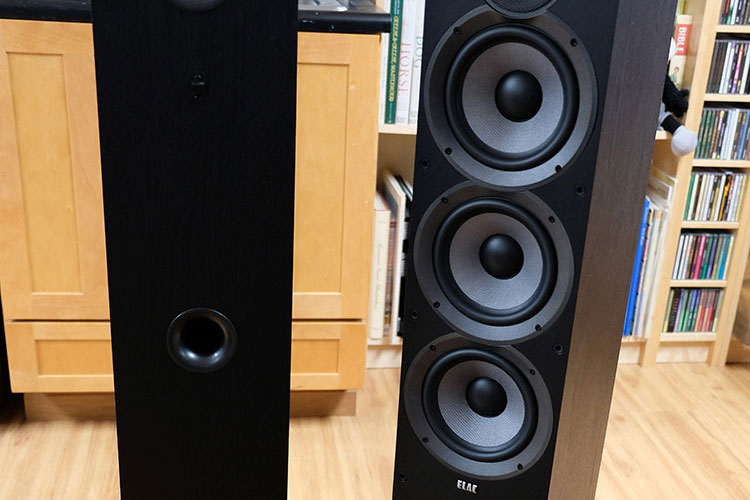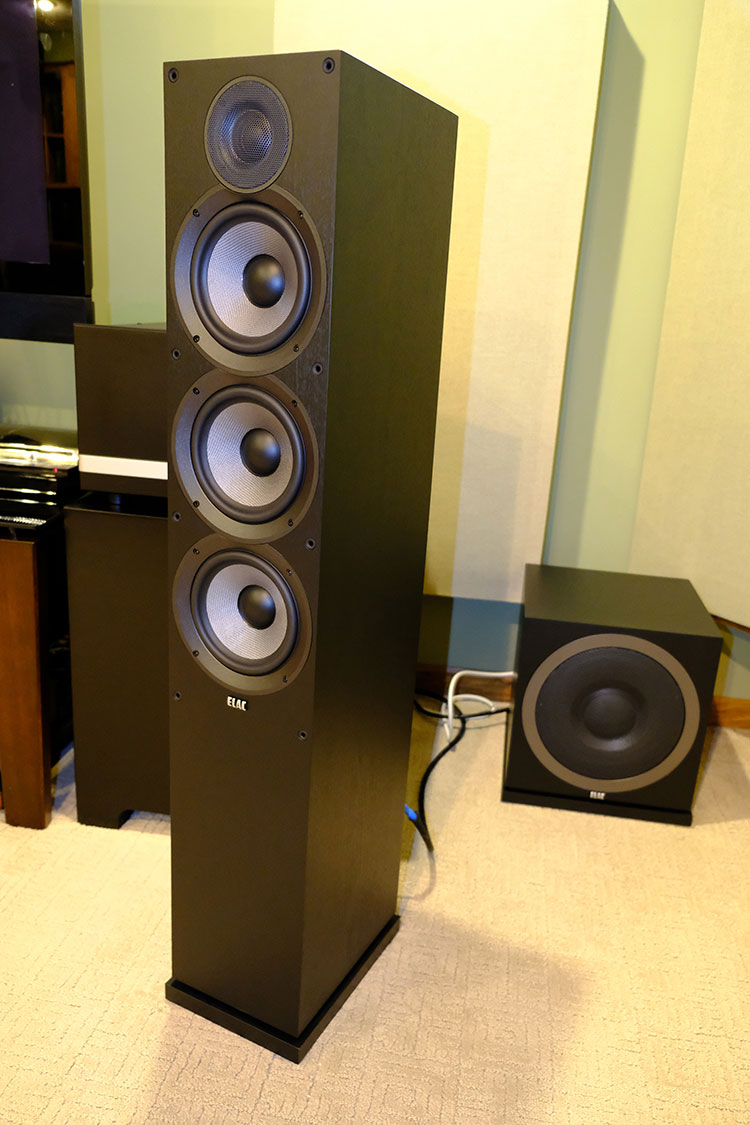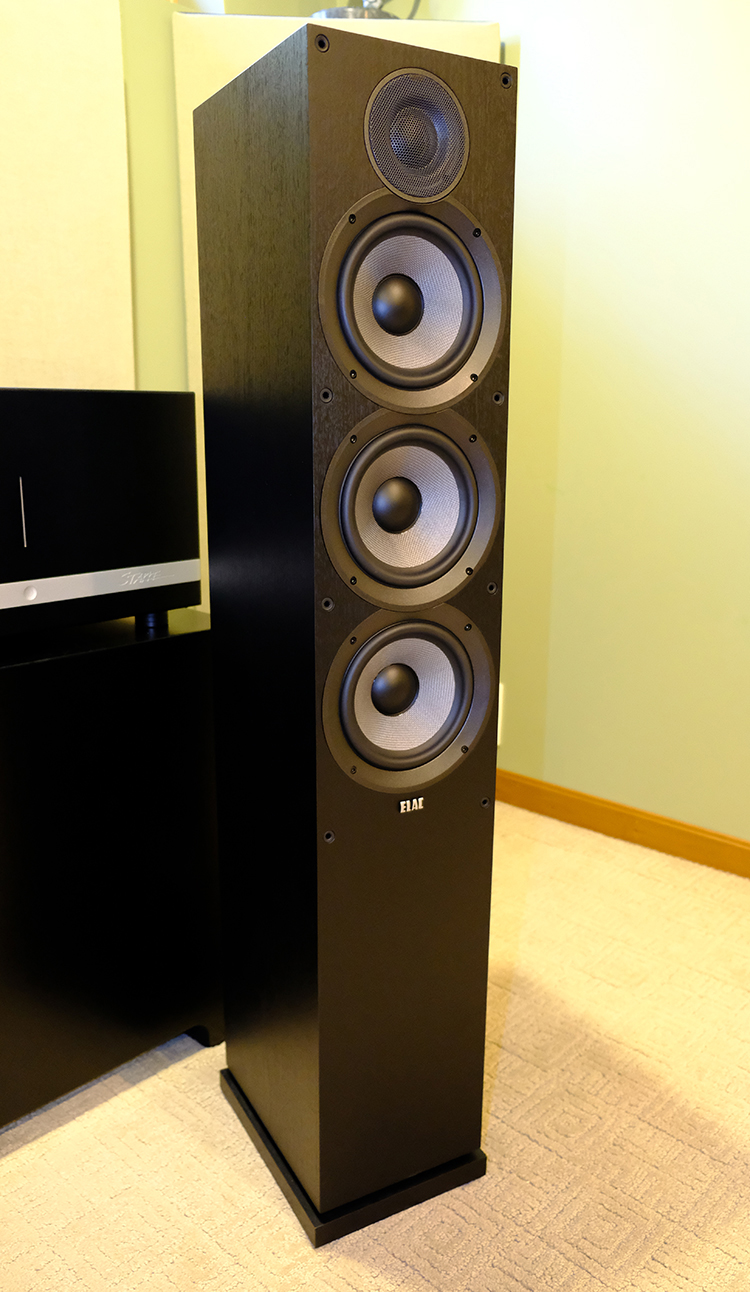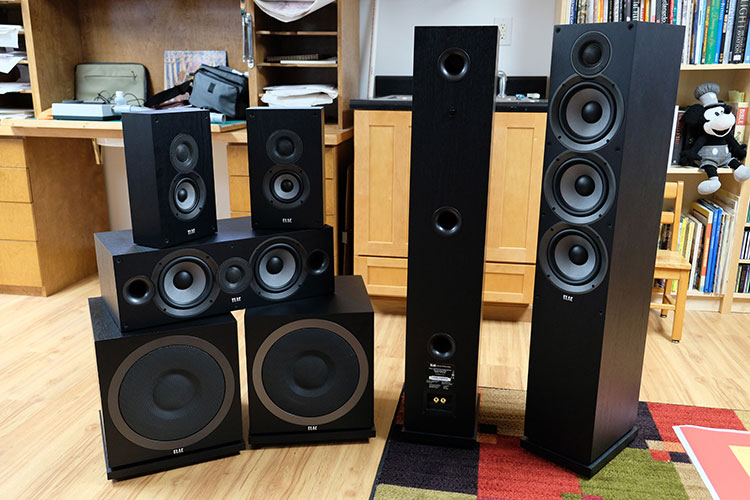
ELAC Debut 2.0 Home Theater Speaker System
- Enjoyable, fatigue-free sound quality with excellent midrange clarity.
- Re-designed drivers, crossovers and enclosures.
- Front baffle width is now similar to the Uni-Fi line. Makes for a slimmer overall look.
- Good bass extension from each speaker model. Perhaps not quite as deep as originals though.
- An on-wall surround speaker is a welcome option. In use, it exceeded my expectations.
- The subwoofer is small, yet potent, and comes with an updated auto-calibration app.
When ELAC first hired well-regarded speaker designer Andrew Jones and product development specialist Chris Walker away from TAD/Pioneer back in 2015, the company made plain the seriousness of their intention to re-establish the brand back in the US market. The first speaker series introduced by this “dynamic duo” was aptly called Debut. It quickly gained widespread acclaim as a well-designed, value-oriented line that punched significantly above its weight. This initial success afforded the team the ability to expand ELAC’s product lines with a number of more adventurous and innovative offerings in both speakers and electronics. In 2016, the company acquired Audio Alchemy and brought aboard key engineers, including founder Peter Madnick, to update the brand he created and continue its life under the ELAC umbrella. In just under four years, ELAC has gone from essentially “Zero to Hero” in the US market, significantly expanding their product, reach and name recognition, all from that initial beach-head they established with the Debut line.
Coming around full circle, Jones and Walker have seen fit to revisit and update their initial success with the recent launch of Debut 2.0. Although similar in appearance to the originals, Andrew Jones has redesigned everything about the updated line. Debut 2.0 incorporates new drivers, new crossovers, re-engineered cabinets, a new on-wall, and extra center channel speaker options to effectively broaden the installation possibilities. ELAC has been kind enough to send me a full home theater speaker package consisting of a pair of F6.2 towers, a C6.2 center channel speaker, a pair of OW4.2 on-wall surround speakers, a pair of B5.2 bookshelf speakers and a pair of SUB3010 active subwoofers. I ended up listening to the speakers in a couple of different stereo configurations and as a full home theater system. In each case, I came away very impressed with the sound quality that is now available for a modest asking price. The B5.2 bookshelf speakers actually found their way into my older son’s bedroom system. The foam surrounds of the older speakers he was using at the time basically dried up and disintegrated. As a 16-year-old who, on more than one occasion, has poo-pooed his father’s fascination with “sound quality” he came away impressed with the new upgrade. Enough so that he asked me if he could contribute some of his thoughts to this review. I was about his age when I first caught the audio bug, so I think this whole stereo hobby of mine may have just come full circle, with this review, as well.
F6.2 Loudspeakers
Design:
3-way Floor-standing Loudspeaker
Low-Mid Frequency Transducers:
Three 6.5” Aramid Fiber Woofers
High-Frequency Transducer:
Single 1” Cloth Dome Tweeter
Maximum Rated Amplifier Power:
140 Watts RMS
Frequency Response (Manufacturer):
39 Hz – 35 kHz
Sensitivity:
87dB (2.83V @ 1M)
Nominal Impedance:
6 Ohm
Crossover Frequency:
90 Hz and 2.2 kHz
Enclosure Type:
Bass-Reflex via Dual Rear-Firing Ports
Inputs:
Five-Way Binding Posts
Dimensions:
43.18” H x 7.69” W x 10.55” D
Finish:
Black Ash Vinyl.
MSRP:
$799.96 (pair)
C6.2 Center Channel Loudspeaker
Design:
2-way Center Channel Loudspeaker
Low-Mid Frequency Transducers:
Dual 6.5” Aramid Fiber Woofers
High-Frequency Transducer:
Single 1” Cloth Dome Tweeter
Maximum Rated Amplifier Power:
120 Watts RMS
Frequency Response (Manufacturer):
55 Hz – 35 kHz
Sensitivity:
88dB (2.83V @ 1M)
Nominal Impedance:
8 Ohm
Crossover Frequency:
2.2 kHz
Enclosure Type:
Bass-Reflex via Dual Front-Firing Ports
Inputs:
Five-Way Binding Posts
Dimensions:
7.61” H x 23.35” W x 10.55” D
Finish:
Black Brushed Vinyl
MSRP:
$279.98 (each)
B5.2 Bookshelf Loudspeaker
Design:
2-way Stand-mount Loudspeaker
Low-Mid Frequency Transducers:
Single 5.25” Aramid Fiber Woofer
High-Frequency Transducer:
Single 1” Cloth Dome Tweeter
Maximum Rated Amplifier Power:
120 Watts RMS
Frequency Response (Manufacturer):
46 Hz – 35 kHz
Sensitivity:
86dB (2.83V @ 1M)
Nominal Impedance:
6 Ohm
Crossover Frequency:
2.2 kHz
Enclosure Type:
Bass-Reflex via Single Front-Firing Port
Inputs:
Five-Way Binding Posts
Dimensions:
13.43” H x 7.09” W x 9.21” D
Finish:
Black Brushed Vinyl
MSRP:
$249.98 (pair)
OW4.2 On-Wall Surround Loudspeaker
Design:
2-way Shallow On-Wall Loudspeaker
Low-Mid Frequency Transducers:
Single 4” Aramid Fiber Woofer
High-Frequency Transducer:
Single 1” Cloth Dome Tweeter
Maximum Rated Amplifier Power:
80 Watts RMS
Frequency Response (Manufacturer):
70 Hz – 35 kHz
Sensitivity:
87dB (2.83V @ 1M)
Nominal Impedance:
6 Ohm
Crossover Frequency:
2.5 kHz
Enclosure Type:
Bass-Reflex via Dual Down-Firing Port
Inputs:
Five-Way Binding Posts
Dimensions:
12.76” H x 7,87” W x 3.94” D
Finish:
Black Brushed Vinyl
MSRP:
$249.98 (each)
SUB3010 Subwoofer
Design:
Powered Subwoofer with Passive Radiator
Drivers:
Single 10” Long-Throw Active Driver with Doped Paper Cone, Single 10” Passive Radiator with Doped Paper Cone
Amplifier Type:
BASH-Tracking
Maximum Rated Amplifier Power:
200 Watts RMS / 400 Watts Peak
Frequency Response (Manufacturer):
28 Hz – 150 Hz
Crossover Frequency:
Continuously Variable (50Hz – 150 Hz)
Inputs:
L/R, LFE RCA
Weight:
32.1 lbs.
Dimensions:
14.33” H x 13.5” W x 13.5” D
Finish:
Black Brushed Vinyl
MSRP:
$449.98 (each)
Company:
SECRETS Tags:
ELAC, Debut 2.0, Bookshelf, Tower, Loudspeaker, Home Theater, Loudspeaker Review 2018

Let’s start by examining the individual speakers that make up this ensemble. The ELAC Debut 2.0 F6.2 floor-standing loudspeaker is a three-way, rear ported bass reflex design. The cabinet shape is slimmer and deeper than the original Debuts, copping a little “Euro-Chi-Chi” style action from ELAC’s Uni-Fi Slim lineup. Internal bracing has been improved so as to dampen any unwanted cabinet resonances, and the brushed vinyl look of the original Debuts has been replaced by a black ash textured wrap finish. As we look at the drivers, the 1” silk dome tweeter is similar to that of its predecessor model but has been updated with a wide-roll surround and new waveguide to help with overall response and improve directivity. Handling the midrange and woofer duties are three identical 6.5” aramid fiber (like Kevlar) drivers. The top one is responsible for midrange play (crossed over from the tweeter at 2.2 kHz), while the lower two are crossed from the mid unit at 90 Hz and handle bass. Again, these are similar to what came in the previous generation model but have a revised cone shape combined with a traditional looking convex dust-cap to increase stiffness and strength. With a nominal impedance of 6 ohms and a sensitivity of 87dB, the F6.2 towers should make for an easy load for most HT receivers to drive.
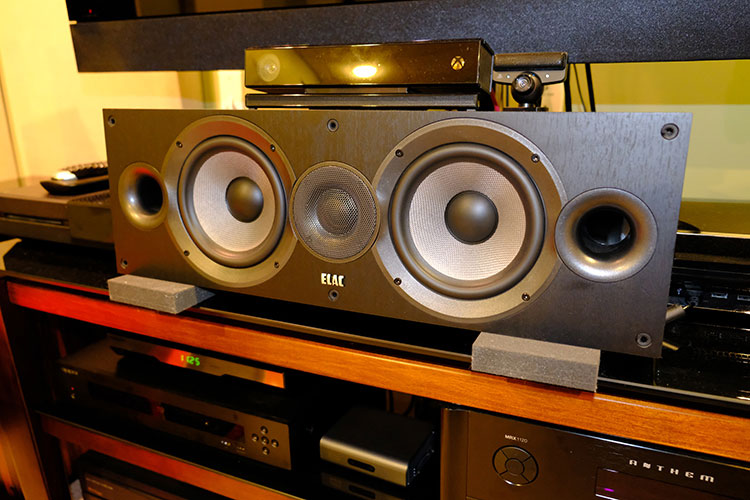

The Debut 2.0 C6.2 center channel speaker shares all the same driver and cabinet improvements that I’ve outlined in the towers. But whereas the previous generation Debut center channel had rear-mounted ports, the new model has them moved to the front to allow more flexibility when placing the speaker in entertainment centers or near walls. An 8-ohm nominal impedance and an 88dB sensitivity will make the C6.2 easier to drive than the original version too.
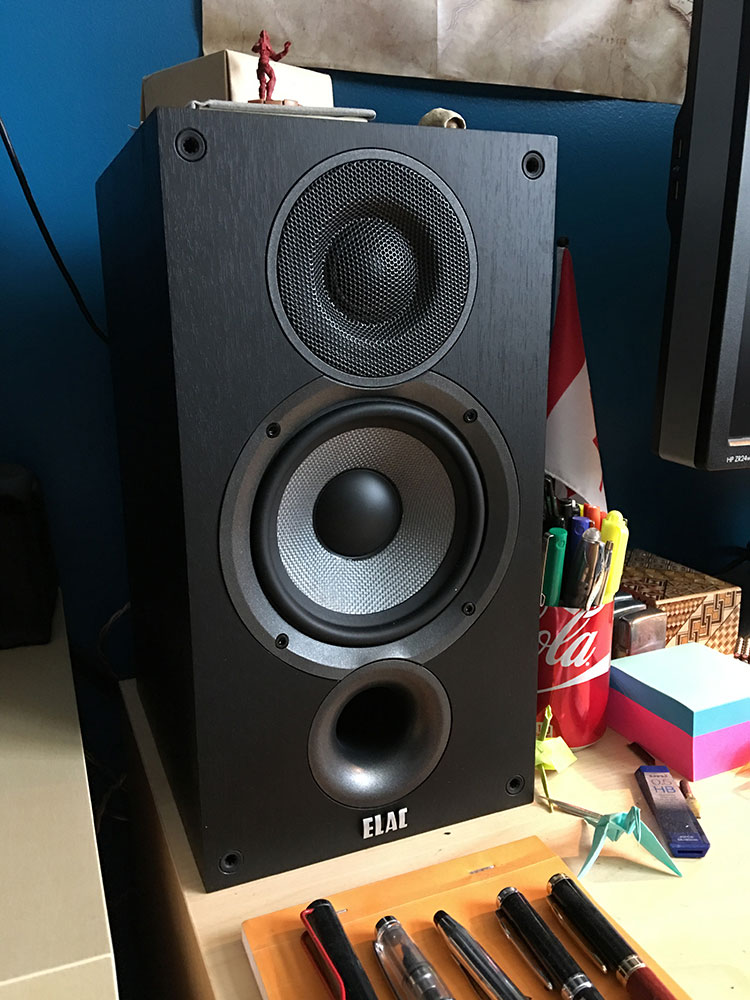

The Debut 2.0 B5.2 bookshelf speaker has all the same design and engineering improvements as the tower speaker, differing only with a front mounted port to ease placement near walls and a using a 5.25” version of the Aramid fiber midrange driver. Compared to the original, the Debut 2.0 B5.2’s slimmer and taller dimensions look particularly good in this speaker format. The claimed 46 Hz bass extension is quite respectable for a speaker of this size and the easy-to-drive impedance follows the template set by the rest of the line.
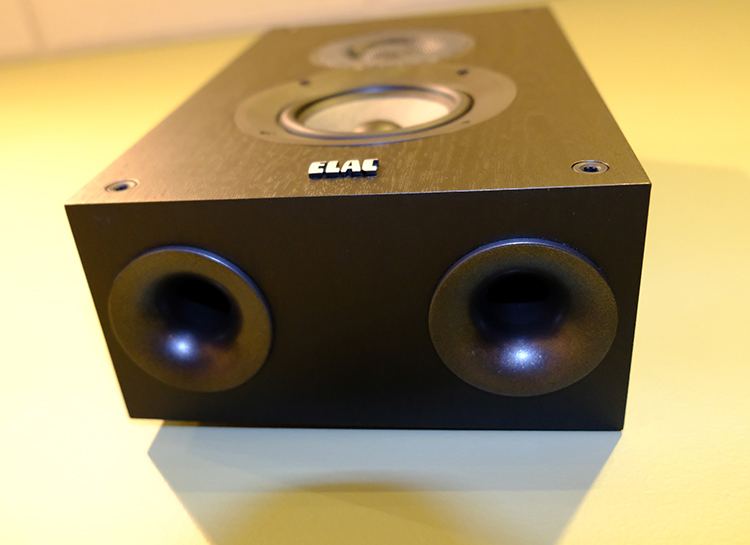
As the only truly all-new design in the Debut 2.0 line, the OW4.2 on-wall surround speaker is a welcome addition that should help broaden the options for various home theater configurations. My own home theater is in a basement room and the inherent layout makes the use of on-wall surround speakers a requirement for me. These speakers use the same tweeter as the other models and a 4” version of the Aramid fiber mid/woofer exclusive to it alone. The simple box enclosure is surprisingly shallow at barely 4” of depth. It’s designed to use the natural acoustic reinforcement provided by the wall (along with two down-firing ports) to extend its bass capability beyond what one might initially expect. As a load, it also should present a non-issue for most HT receivers available today.
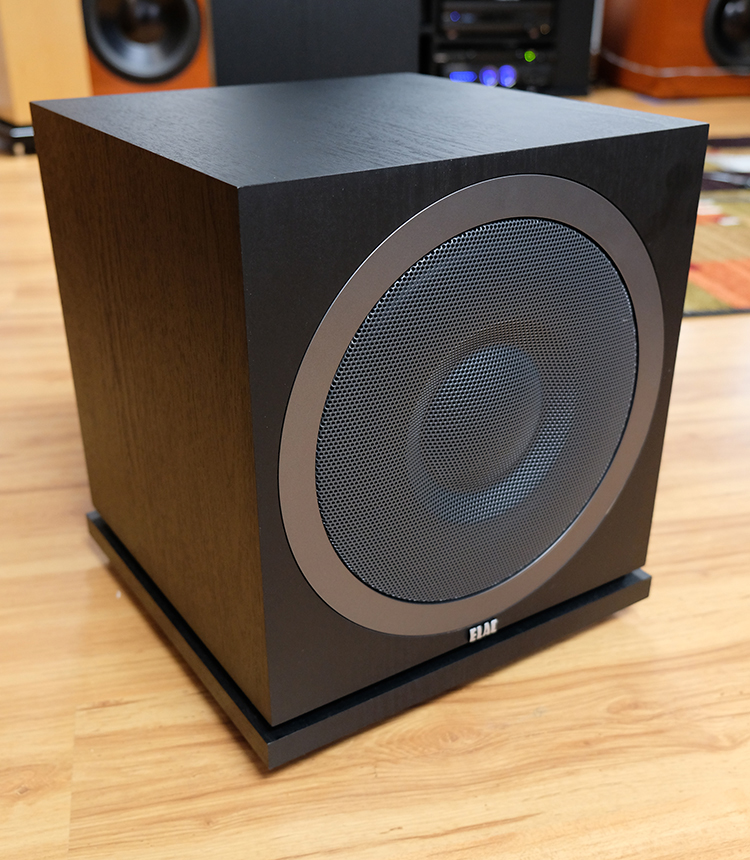
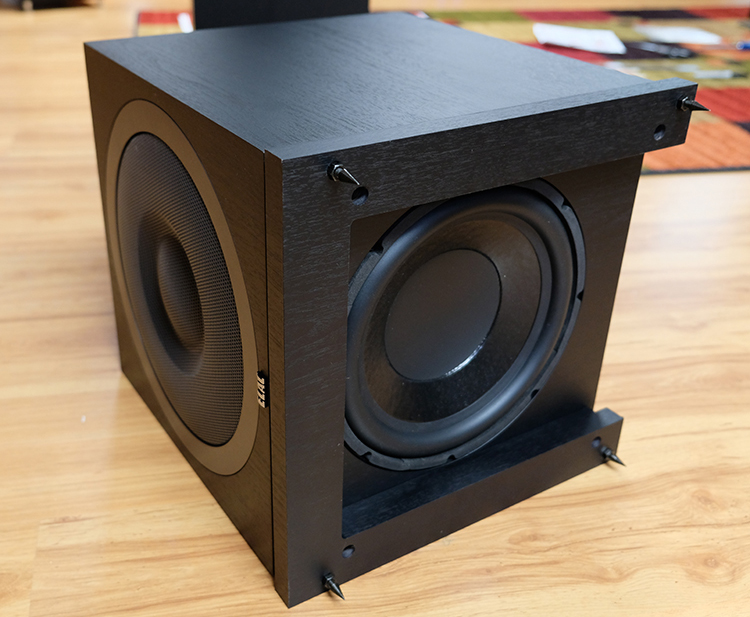
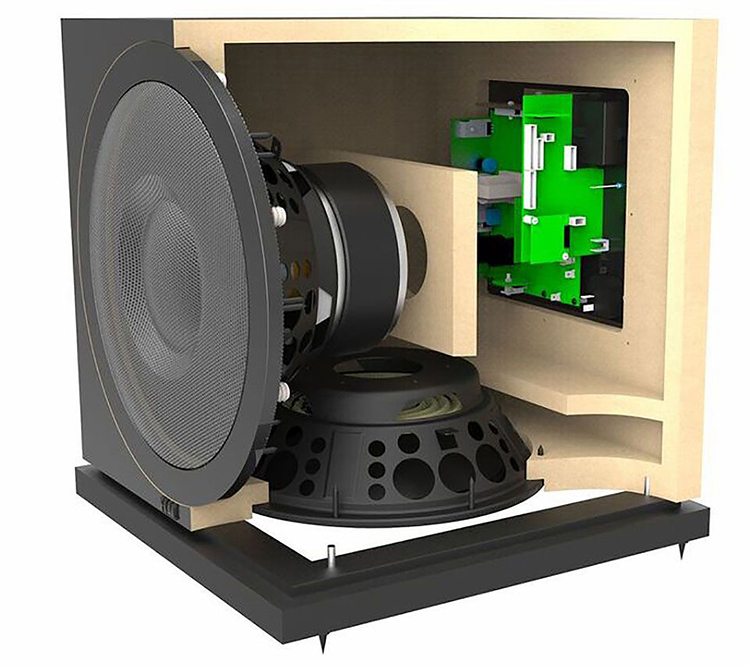
The SUB3010 Subwoofer is a modestly sized 14” cube containing a front-firing, 10”, doped paper, long-throw driver. This works in tandem with a down-firing 10” passive radiator to help get to the lowest frequencies and maximize output. The drivers are backed up by a 200-watt RMS (400-watt Peak) BASH style, internal power amplifier. The SUB3010 is also equipped with a custom Auto EQ system that is controlled via a downloadable app that is available for Android and iOS. The app first discovers and pairs with the SUB3010 via Bluetooth. Then the app and the sub use the built-in microphone of your tablet or smartphone to take measurements of the sub at both the nearfield and then the listening position. Using this data, the app then creates a correction curve which it subsequently uploads to the sub. You can also manually tune the sub, through the app, via a 12-band parametric EQ that’s included. As a matter of fact, the app controls all facets of the sub’s volume and tuning. As such, the back of the SUB3010 features no controls whatsoever. All that resides on the sub’s back panel is the L-R/LFE input jacks, a status LED, a small Reset button and a USB connection for servicing. As with the other Debut 2.0 speakers, the SUB3010 is finished in a textured black ash wrap.
For some initial 2-channel enjoyment, I had the F6.2 towers set up in my studio listening area positioned about 9-feet apart and toed-in at about a 10-degree angle. My seating position was also just about 9-feet away from either speaker. An OPPO BDP-105D Universal Player served as the main source while my Bryston BP25 preamp and Class D Audio SDS 470C power amp completed the audio chain.
For surround listening, the Debut 2.0 tower speakers, center channel, on-walls, and dual subs were set up in my basement home theater space in my typical 5.2 surround layout.
The speakers presented no unusual installation or placement challenges. The on-wall speakers each came with a set of low-profile mounting brackets that were simple to install. After some experimentation, I settled on the two front corners to be the best place for each of the SUB3010 subwoofers to take up residence. Please refer to the above video to see how the subwoofer’s app-based auto calibration routine works. In my standard HT setup, I also have four GoldenEar SuperSat 3 speakers mounted high (where the wall meets the ceiling) and aimed at the listening area for use as Dolby ATMOS height speakers. The speakers were all controlled and powered by an Anthem MRX 1120 HT receiver with an OPPO BDP-103 Universal Player as the source. All the speakers were acoustically dialed in using Anthem’s ARC room correction system and were crossed over to the subs at 80 Hz. This setup left the two ELAC bookshelf speakers without a job until my son’s bedroom stereo speakers decided to give up the ghost. The ELAC B5.2 speakers thus found themselves a home situated at the back corners of his desk, powered by an old Denon all-in-one component system that puts out about 25 watts per channel.
When it strictly comes to looks, the ELAC Debut 2.0 speakers are about as straightforward and unassuming as you might expect, given their value-oriented nature. As simple black boxes go, I have seen bigger ones that visually dominate a room far more than these do. The svelte faces of the Debut 2.0 help them to disappear a bit and draw less attention to themselves. The build quality seemed uniformly good throughout. I noticed no surface blemishes on any of the finishes and the cabinets felt firmly put together and elicited no hollow noises when subjected to the knuckle-rap test.
Secrets Sponsor
Speaking of overall sound quality, I remember that when I first heard the original Debut speakers during their introduction, the first thing that struck me was the level and impact of the bass those speakers put out. What grabs my attention with these updated models is the midrange clarity and presence, especially when I just had the towers in my studio for stereo listening. Male and female jazz vocals, for example, had a great balanced quality to them that didn’t sound overly forward. Instrumentation in this region sounded sufficiently clean and detailed without adding any undue coloration to what I was hearing. Piano notes had a pure and clean sounding ring to them. The overall bass response seemed potent with plenty of reach and impact. Kick drum was impressively solid sounding, and feeling, for speakers of this size placed well into my 27’ x 35’ studio space. The high-frequency performance of the towers was also of commensurately good quality. Perhaps a little on the polite side, but still with plenty of detail on orchestral strings, flute, and brass. The cloth dome tweeter definitely didn’t show any signs of breakup or exhibit any abrasive sounding behavior with any of the usual material that I use to check for this. Blues harmonica sounded especially alive through the F6.2 towers and they sure didn’t seem to stress when I pushed them to higher volumes with some hard rock or metal. These ELAC F6.2 tower speakers exhibit the kind of sound quality that, frankly, I would associate with speakers costing at least twice their $800.00 per pair asking price. The fact that they are available for the price that they are, means that there is no excuse for anyone to settle for poor sound quality today. As a standalone pair of speakers, they are one heck of an achievement and, quite honestly, a stupid-good value.
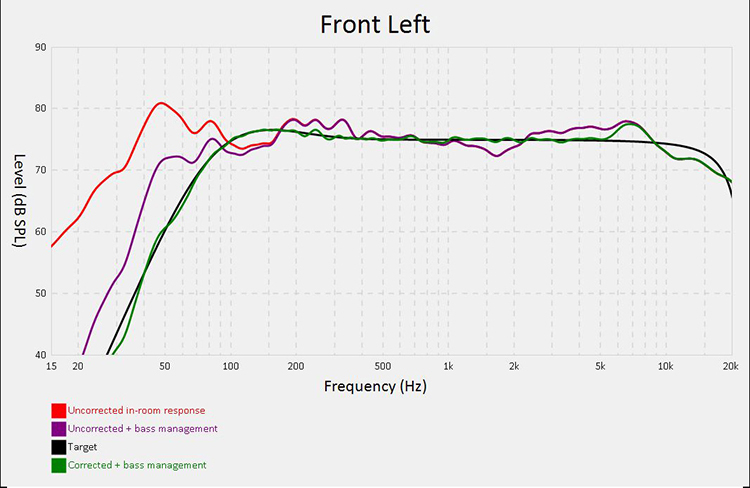
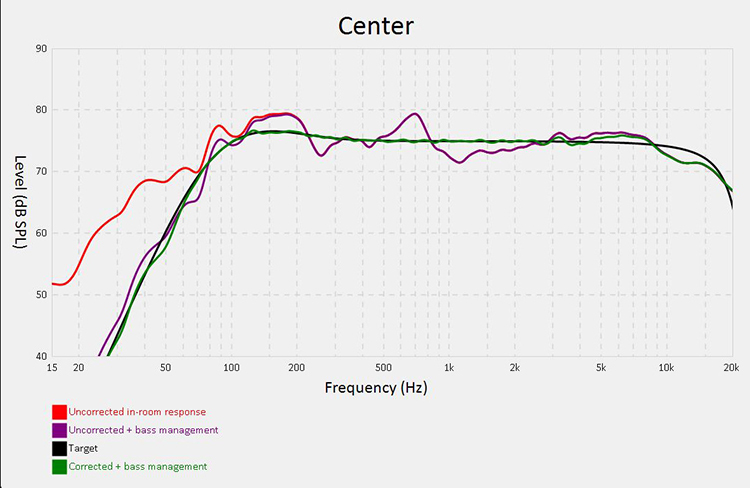
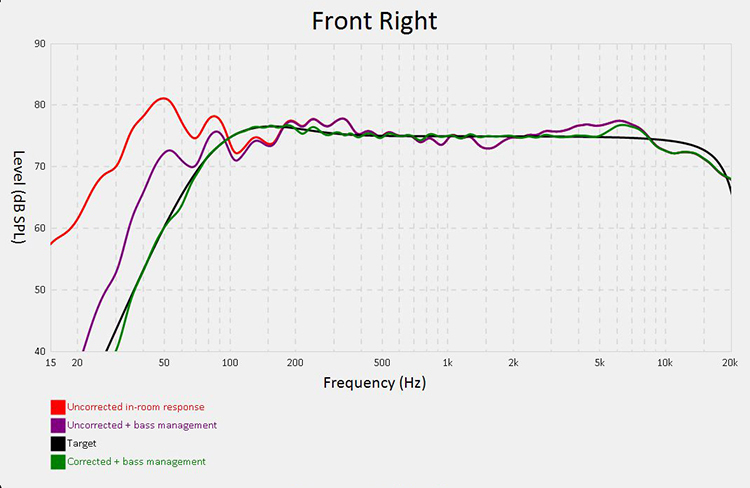
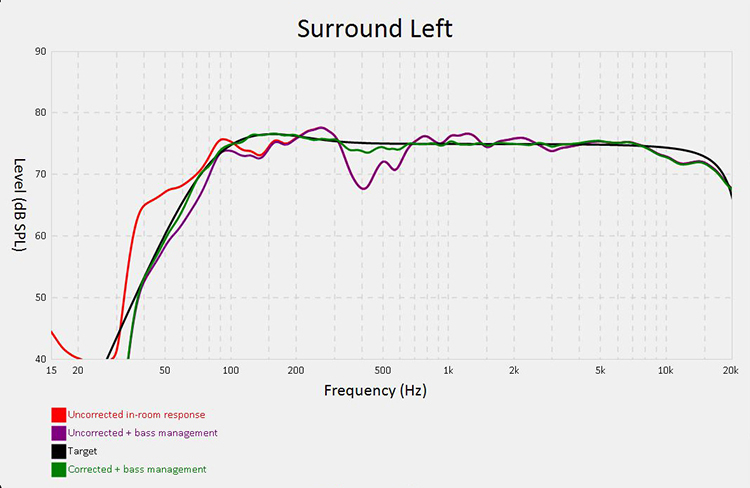
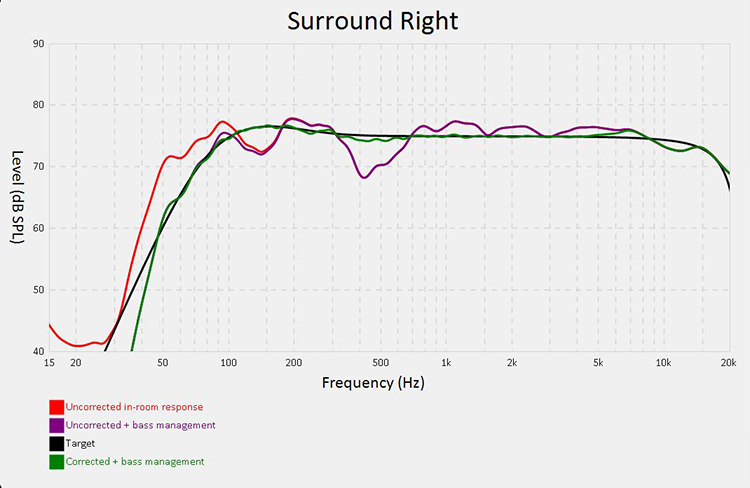
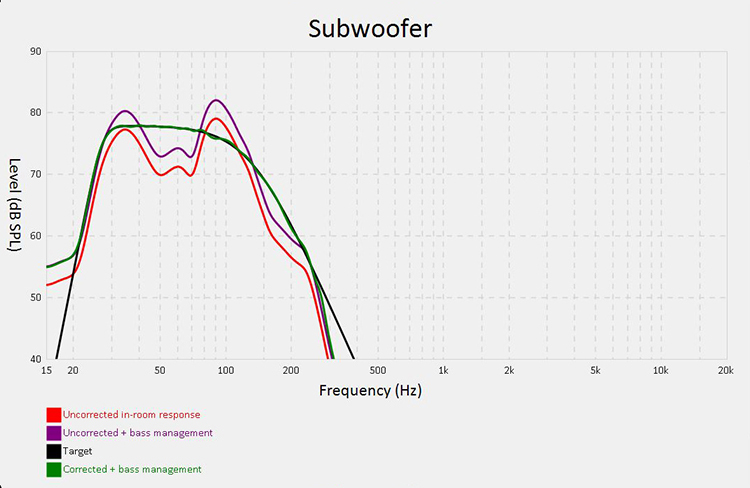
As a complete home theater system, the ELAC Debut 2.0 present themselves as a thoroughly, sonically seamless package. Listening to some surround sound music material quickly revealed how tightly voiced this entire system is. There was no noticeable timbral change when music moved from towers to center to surrounds and back. Even when using the ARC room correction on my Anthem receiver, the default auto-calibration settings did not need to go beyond 5 kHz. Even when I dialed the correction back to max out at 2 kHz, there was minimal change in what I was hearing. Regarding the subwoofers, I had listened to the system with the bass calibrated both with ARC alone and with ARC relinquishing the bass calibration duties exclusively to ELAC’s subwoofer auto-cal routine. In practice, you want to avoid having both systems active at the same time, essentially EQ over EQ, which can lead to unpredictable results. Each bass calibration scenario yielded excellent results to my ears with neither being the clear superior over the other. Kudos go to ELAC for including such a system with their subwoofers. If one doesn’t have a room correction system or has a less than capable one built into their HT receivers, ELAC’s effective sub calibration system allows an owner to tame and adjust the hardest part of the audio spectrum to fix. My only issue with this subwoofer actually has to do with the calibration app. The current app is called Sub Control 2.0 and unlike the original version of this app that I used with the SUB10EQ in my ELAC Uni-Fi Slim Speaker review, this version does not visually recall the auto calibration correction curve that is currently loaded into the Sub3010. You only get to see if Auto-EQ is active or not. Once you run the calibration and accept the results, they are loaded into the sub and you never get to see the results graph again. The original Sub Control app allowed me to recall the curve when I wanted, and I wish the latest app did that as well. As is usual with subs in my home theater, once the calibration between subs and the rest of the speakers is smooth and seamless, I mildly adjust the Room Gain settings in ARC and bump up the after-calibration levels of each sub by about +2dB. This essentially creates a modest “House Curve” that I find restores the bass impact that I look for in movies and music without bloating the overall bass sound. The twin SUB3010 subwoofers acquitted themselves really well in my listening room. Once calibrated, the multiple subs evened out bass response across all four of our seats. And the subs now had a tight, punchy sound quality that worked well with everything we listened to. The fact that they were also physically small and easy to place was an added bonus. The price, size and performance aspects of these subs make a good case for purchasing them in multiples.
The C6.2 center channel speaker proved itself to be an excellent sounding anchor to the whole system, providing highly intelligible dialog and clean musical performance in an easily manageable size. It noticeably sounded just as good while sitting in either of our end seats as it did when sitting in the two middle seats. That isn’t always the case, as some center channel speakers I’ve had installed here can have an audibly softer sound for guests in the end chairs. Vocals in both music and movies had a natural presence and weight to them and panning effects between the front three speakers sounded as seamless as could be.
On an individual basis, I think it would be fair to say it was the little OW4.2 on wall speakers’ performance that surprised me the most. Their low-profile design and the smaller mid-woofer driver did not have me expecting very much initially. But ARC found them to have a low-enough reach to set an 80 Hz crossover automatically and my ears found them to be able to throw a massive and convincing rear sound field. For movies, rear effects sounded big and bold when they needed to, yet there was plenty of detail to render the subtleties of things like raindrops, birds chirping and distant sound cues effectively. For surround music, the story was the same. The little OW4.2s were more than able to keep up with the larger front 3 speakers in painting a complete and enveloping sonic picture. Best of all, not only were sounds panning from back to front seamless in image and timbre, but pans that moved from side to back to other side were completely convincing. I don’t know what magic sauce Andrew Jones used to garnish these little dynamos but let’s just say they had me “eating my hat” on more than a few occasions! If I had one nitpick about them, it would be that I wish that the binding posts were mounted in recessed pockets built into the top or a side of the cabinet. I think it would just make for an easier time of hooking up the speaker wire during installation.
The following are a few notable music and movie selections that I felt showed off the ELAC Debut 2.0 speakers well during my review:
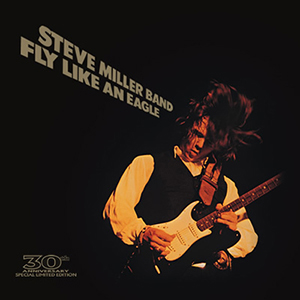
30th Anniversary 5.1 Surround mix, Capitol Records.
Being the age that I am, it goes without saying that I am more than a little familiar with this album having owned it on vinyl, cassette tape, and CD. Even though this 5.1 Surround mix is only 16-bit/48 kHz resolution, that’s more than sufficient for this material and it’s a hell of a lot of fun to listen to.
Right from the opening of “Space Intro” the circular panning synthesizer effect is completely encompassing and seamlessly transitions from rear to the side to front and across.
There were no audible gaps in the imaging and as each speaker hands off sound to the next, there was no noticeable change in volume or tone. As the song transitions into “Fly Like an Eagle,” the trademark opening guitar riff that starts off in the left channel sounds perfectly detailed and crisp followed by the punchy panning drum roll moving from left to right. As the song gets moving, Steve Miller’s main vocals are coming mainly from the center channel and sound nicely weighted and anchored, accompanied by his “Tick-Tock-Tick” backing vocal that ping-pongs between the OW4.2 surrounds. There are a ton of moving parts to this song and the ELAC Debut 2.0s, as a system, layer everything with a balanced harmony of presentation. Yet, all the while, you are still able to pick out great little individual elements, like how the F6.2 tweeters present the texture of the sizzling cymbal parts in the opening of this track. James Cotton’s harmonica work on the song “Sweet Maree” comes across with a great amount of detail, revealing a lot of the subtleties in the soulful performance without ever veering into harshness. The same applies to Miller’s acoustic guitar work happening in the surround channels too.

Various Artists, AIX Records Music, and Audio: A User Guide to Better Sound Blu-Ray Disc, 24/96-5.1 Dolby True HD, AIX Records. Mark Waldrep’s recent book “Music and Audio: A User Guide to Better Sound” includes a calibration and demonstration disc with a number of complete cuts from some of the various surround sound music projects he has produced. There are a few different audio presentation choices and I selected the “5.1 Stage” option which is mixed with the listener placed in the middle of the performance. Starting with John Gorka’s “Let Them In”, Gorka’s soft-spoken singing was perfectly imaged by the C6.2 center channel speaker. Detailed enough to precisely capture the nuances of his breathing between lyrics, it also excelled at rendering some of the deeper resonances of his vocal range too. The tonality and rich sound of the grand piano that he played also stuck out as a strong suit of the F6.2 towers’ performance, and the subsequent reverberation of the notes smoothly transitioned into the surround channels. The accompanying mandolin part was also handled well by the Debut 2.0 ensemble. Sometimes certain speakers will give this instrument an un-natural metallic sound to its playback with the occasional unpleasant driver resonance, happening in the worst circumstances. Neither the towers or the OW4.2 surrounds had any difficulties and the mandolin notes sounded completely natural, with the proper acoustic ring to its character, as its playback moved from front to back.
Moving to “All the Things You Are” performed by James Walker (flutist) and Free Flight, Walker’s flute performance was handled deftly by the ELAC Debut 2.0s. Again, there was lots of detail retrieval in the individual notes, with good tonality, and I could easily make out Walker’s breathing during his playing. I want to say that some of the highest notes were a little mellower sounding than I remember on some other speakers that I like but not objectionably so. “Smooth and clean” are the top-of-mind descriptors that I wrote in my notes. Same applies to the accompanying piano which stayed more in the higher registers than the one in the Gorka track. The electric bass solo in this song was great food for the subwoofers. The notes had plenty of punch and dimension along with some good string detail that I was able to pick out from the bassist’s aggressive plucking style. Another great sounding test track was “It Was a Lover and His Lass” from the a cappella group Zephyr. Twelve vocalists, recorded in the round, with no other instrumentation would be useful in assessing the critical midrange performance of each individual speaker. The Debut 2.0 system sailed through this track creating the convincing illusion of being surrounded by vocalists ranging from sopranos to baritones. Each speaker seemed to have an identical midrange character, all were very clean and revealing, showing off the lovely tonal purity that these singers all have. And none of the speakers had any issues with the varied vocal ranges. As before, it was the on-wall surrounds that surprised here, subjectively matching the sound quality and dynamics of the towers and the center thus fully completing the dimensional picture.

So far, Solo and Rogue One have been the only two enjoyable bright spots in a depressing array of Star Wars prequels and sequels. Both George Lucas and the folks at Disney seemed to have forgotten just what the heck made the original trilogy so special. Never mind all the silly back-and-forth internet banter about the appropriateness of this character or that. Who cares, get the story and the feel right first! Ahem, but I digress….
I found Solo, as a movie, immensely enjoyable and while the 7.1 DTS Master Audio soundtrack was not the most immersive one I’ve ever heard, it did have some bright spots and overall great fidelity. During Han and Qi’ra’s initial escape attempt on Corellia, while they are fleeing in a speeder-type vehicle and being chased by their pursuers, the surround effects are quite aggressive and effective. Sounds of blaster fire, flying debris, impact noises and the lot were happening all around me and all sounded very detailed and tracked smoothly. The subwoofers got a bit more of a workout during the elevated train-heist scene and when our heroes were engulfed in the Maelstrom during the Kessel Run sequence. The twin SUB3010s added a tight and impactful foundation that ably shook my room at times, particularly during the Maelstrom event. Here too, the OW4.2 on-wall surrounds were up to the challenge, successfully relaying all the spatial cues that made being on the Millennium Falcon, while flying through the Maelstrom, a believably claustrophobic experience.

It still sort of amazes me that this franchise has carried on for as long as it has but, putting that aside, the actors, story and first-rate visual and audio quality make for an enjoyable time with this particular entry. The ELAC Debut 2.0 system just had a field day with this soundtrack, right from the word “Go”! I felt that every channel got to completely show off its dynamic capabilities.
Each got to render a full dinosaur roar at some point in this movie, and none of the channels showed any signs of distress in doing so. The entire volcano eruption and island escape scene was an immersive audio feast with dinosaurs running and flying around and past me. The dinosaur footfalls combined with the volcano had the twin subwoofers working overtime and they showed no signs of balking at the task. I felt every explosion and footfall solidly, and the room shook noticeably a few times during this flick. Dialog remained rich and clear with good volume, courtesy of the C6.2 center channel. The OW4.2 surrounds could not have performed better, completely filling the side and back sound fields and blending seamlessly with the fronts. The final climactic confrontation with the hybrid dinosaur and the lead characters on the roof of the mansion, during a thunderstorm, is quite epic with sound effects and spatial cues steered all over the place. From an audio standpoint, this movie was the whole enchilada, and the Debut 2.0s served it up with a side of hot sauce!

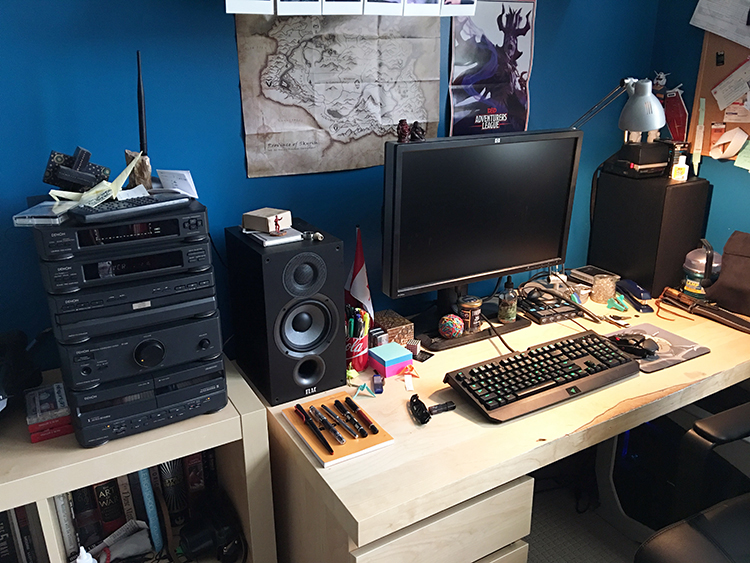
In order to evaluate the bass response that the speakers could produce, I listened to “A Shaving of the Horn That Speared You” by the band Sunn O))), a hulking monster of a song that takes up an entire side of a double LP on its own. The low end is strong with just the two stereo speakers, doing Sunn O)))’s drone remarkable justice without the aid of a subwoofer. I usually use earbuds to listen to music, and I noticed a few details that shone through notably better on the ELAC B5.2s than they did with my in-ears. Overall, I observed a more full and complete sound than my usual impression. For a more comprehensive evaluation of what the speakers could do, I played Trivium’s album “The Sin and The Sentence”. On the song “Betrayer”, the blistering drum intro and opening scream sound similar to the usual in-ear rendition, but the verse guitar part that usually gets lost with earbuds cuts through and makes itself known. I listened to several other albums with these speakers, like Code Orange’s “Forever” and Elder’s “Lore”. All sounded much better than what I was used to hearing with my earbuds or the old Denon speakers that originally came with the system that I’m using.
At this point, I shifted away from vinyl and towards digital. I queued up “Cold Flesh Citadel” by Katalepsy to see how the speakers handled very percussive lows that contrast with the highs. I have noticed that with this particular song, lower quality earbuds turn the kick drums into a kill-switch that effectively mutes the higher range. The ELAC speakers had no problem with this, the kick drums and slamming guitars did not hinder the highs at all and yielded a complete, undisturbed musical experience. After that, I set about the task of throwing music at the speakers with no particular pattern in mind, listening for any issues that I could perceive. The walls of feedback on Eyehategod’s “Take as Needed for Pain” album and the oppressive hardcore assault of “You Will Never be One of Us” by Nails were no issue for these speakers, portraying the various tracks with a well-rounded sound that showed no distress at higher volumes and had little unappealing aspects (it should be noted that I am by no means an audiophile that knows what to look for in these circumstances, I’m just a somewhat discerning headbanger that likes loud, interesting music). Remarkably, I was able to make out some structure in Taake’s “Manndaudsvinter” demo, which normally sounds like one long, insurmountable fuzzed-out power chord through earbuds. Overall, these speakers made a fine replacement for the enfeebled and rapidly deteriorating ones that I used before. They are quite enjoyable.
Equipment used: Denon D-500 Component System, Pro-Ject Audio RPM5 Carbon Turntable, Sumiko Amethyst MM Cartridge, Emotiva XPS-1 Phono Preamplifier.




Secrets Sponsor
Benchmark audio tests of the ELAC Debut 2.0 speakers were conducted using a calibrated Umik-1 USB microphone used in conjunction with Room EQ Wizard software. Speaker on and off-axis measurements were conducted with the microphone placed at a 1-meter distance. Subwoofer measurements were done with the microphone placed at 1-foot away from each respective driver.
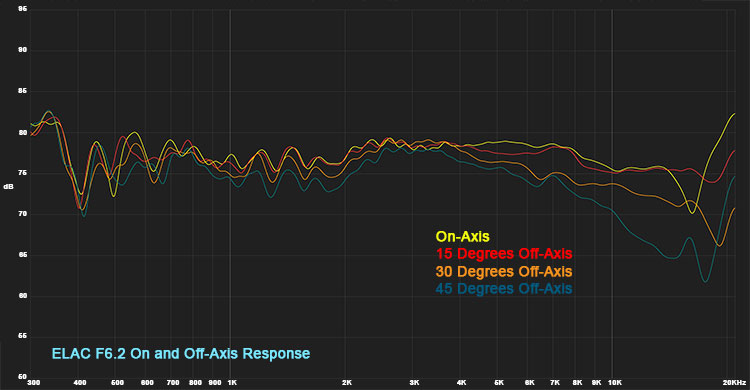
This chart shows the horizontal on-axis frequency response of the ELAC F6.2 speakers directly compared to its 15, 30 and 45-degree off-axis measurements. Everything below 300 Hz is governed by room modes and is less of a concern at this point with this measurement. The 0-degree and 15-degree plots track each other fairly closely between 300Hz to 15 kHz. The 30 and 45-degree plots stay admirably close to the first two until about 3.5 kHz where they begin to show the expected amount of decline.

This graph shows the listening window response of the ELAC F6.2 tower speakers, following the CEA-2034A standard. The CEA-2034A listening window response is an 8-point average comprised of the following measurements: on-axis; -10, 10, -20, 20, -30, and 30 degrees off-axis horizontally; -10 and 10 degrees off-axis vertically. The response between 350Hz and about 12 kHz remains commendably within +/-2.5dB of variation.
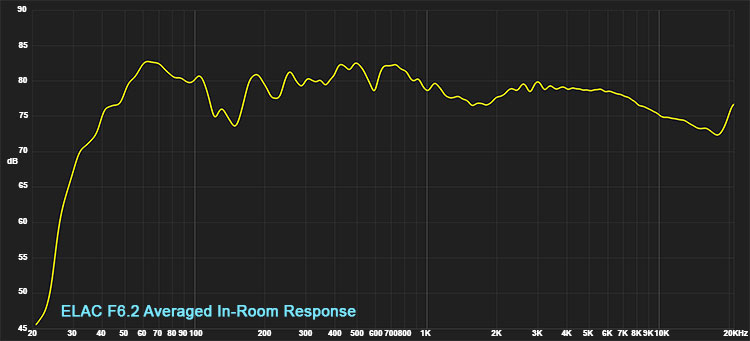
This graph shows an averaged in-room response of the F6.2 that was culled from 10 measurements taken at various points around the main listening area. Unlike the on-axis measurement, this tries to give a better indication of what the speaker’s legitimate response is. The entire plot looks fairly uniform and well behaved with a major dip at 150Hz which is a room artifact. The bass response begins to roll off at about 58 Hz which is notably earlier than spec.
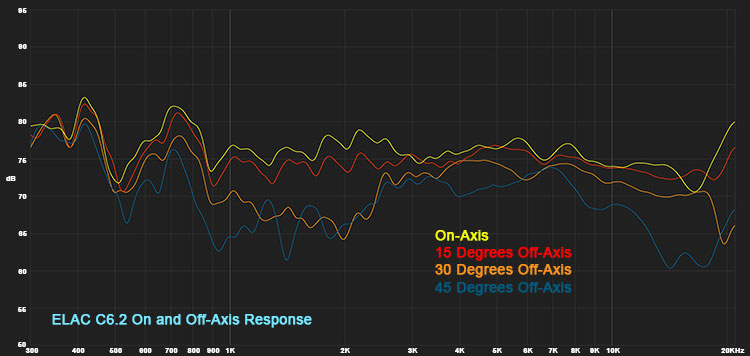
This chart shows the horizontal on-axis frequency response of the ELAC C6.2 center speaker directly compared to its 15, 30 and 45-degree off-axis measurements. The 0-degree and 15-degree plots track each other fairly closely between 300Hz to 12 kHz. The 30 and 45-degree plots vary a little more than expected from 500Hz to 3 kHz, after which they show the expected amount of decline.
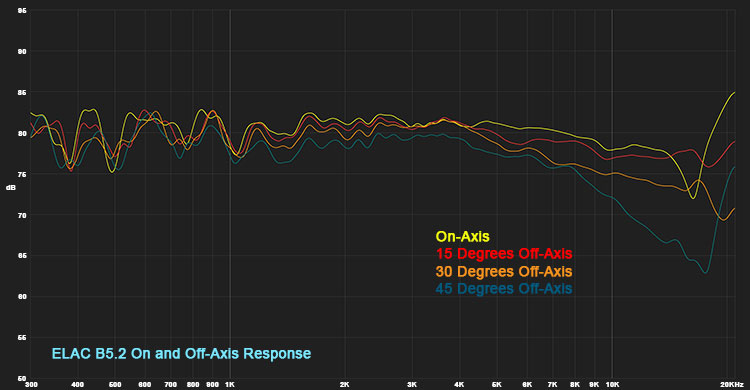
This chart shows the horizontal on-axis frequency response of the ELAC B5.2 speakers directly compared to its 15, 30 and 45-degree off-axis measurements. Overall, it seems an even tighter grouping than that of the related F6.2 plots. The 0-degree and 15-degree plots track each other fairly closely between 300Hz to 15 kHz. The 30 and 45-degree plots stay close to the first two until about 3.5 kHz where they begin to show the expected amount of decline.
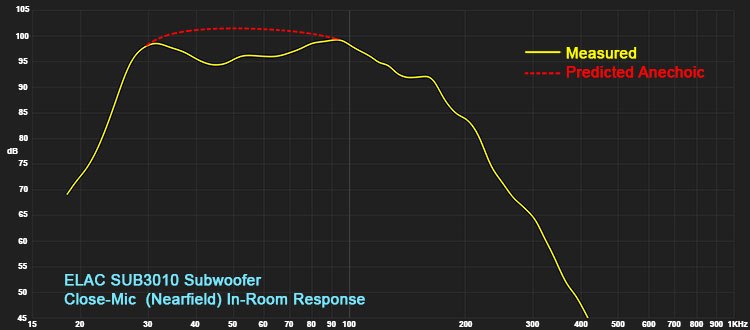
This graph shows the close-mic’d frequency response of both the subwoofer driver and passive radiator summed together without any equalization applied. While this nearfield measurement shows a bit of dip in the middle of the passband, it is just a limitation of testing in my environment and is well within reason. The red trace predicts how the response would appear in an anechoic environment. The low-end response begins to roll off at 28 Hz which is to spec.
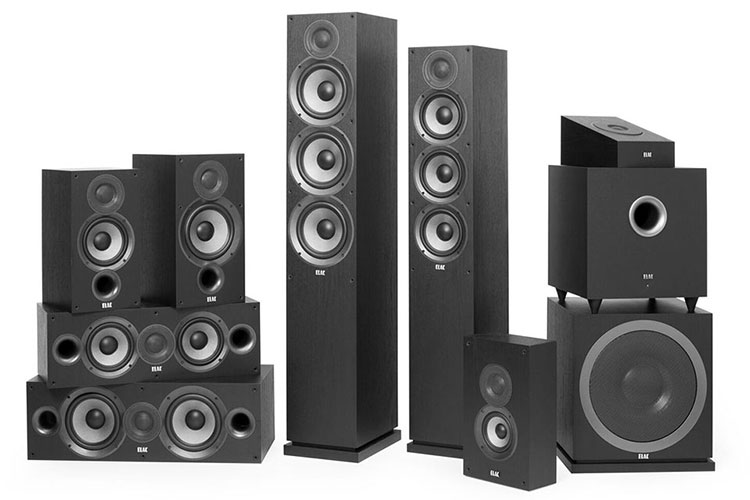
An unbelievable value in speakers. Don’t walk, run out and listen to the ELAC DEBUT 2.0 SERIES.
- Simple unobtrusive styling and solid build quality.
- Impressive overall sound quality that belies their price points.
- Seamless, uniform voicing and presentation in surround sound use.
- On-wall surrounds are astonishingly effective.
- Subwoofer Auto-EQ works well and App suite provides an innovative range of control.
- Top or side mounted binding posts for on-wall surrounds for added ease of installation.
- Ability to visually recall the calibration curve in use on the Sub Control 2.0 app.
ELAC has really knocked one out of the park with the Debut 2.0 speaker line. On an individual basis, both the F6.2 floor standers and the B5.2 bookshelf speakers that I had here were each great sounding options to use in a stereo system. Both had outstanding midrange and treble clarity along with plenty of clean sounding bass to satisfy most discerning listeners. That appealing sound quality, along with their straightforward looks and affordable prices, allows anyone to set up a fantastic sounding system (whether it’s their first or latest) that needs no apologies or qualifiers. When assembled into a home theater system, you will be treated to a seamless and thoroughly enveloping audio presentation. One that you would think should cost significantly more than ELAC’s asking price ($2479.86 for the 5.2 channel system that I was listening to). The SUB3010 is a fairly diminutive but potent little subwoofer that provides plenty of solid bass for most tastes and the novel calibration and control app adds significant tuning flexibility to whatever other upstream hardware you are using. And the bonus is that they are affordable enough to use in multiples. The little OW4.2 on-wall surrounds were the surprise “giant-killer” for me. They don’t look like much, but boy do they deliver the kind of sound quality and sense of immersion that shames larger and more elaborate on-walls that I’ve had here. It’s really rather unbelievable! This is not to say that the Debut 2.0 utterly destroys any of the bigger or more capable and elaborate systems out there that cost significantly more coin. What I do say is that Mr. Jones, Mr. Walker and the rest of the folks at the ELAC mothership have taken a hefty chunk of what makes those expensive systems so great and brought it down to a point where anyone, with a little time and care, can set up a truly knockout system. And that is a pretty “Kick-Ass” achievement!


